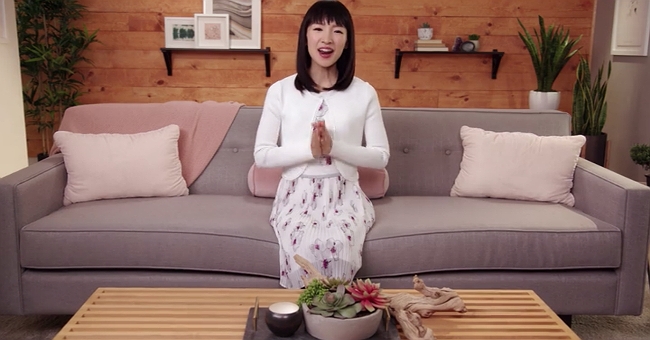
People watch home improvement shows for a lot of reasons, but the most universal reason is that we’re all works in progress. Forget, for a moment, about the hate-watching that comes with ridiculous house-hunting budgets from people with careers that can’t possibly make actual money. What’s satisfying about some of the better shows out there is that you get the sense people are actually improving their lives while there just happen to be cameras around to document it.
People need to find a new home or make their existing home better, and so we watch them get good professional advice and complete this process. Even that endless list of house-flipping shows out there, at least in theory, are about personal enhancement of some sort. Those brothers or the married couple are going to take a mess of a floor plan and eventually make it someone’s home. At significant markup, of course.
There is something uniquely humane about watching people improve their lives. Organizing and bringing about a sense of structure to things is soothing. It’s what makes this video so infuriating, because there’s something innately alluring about just finally having your shit together. Which is why the current buzz around Tidying Up With Marie Kondo makes sense. The show, at least on the surface, hits all of the things that make real home improvement a satisfying binge watch.
Tidying Up premiered on New Year’s Day on Netflix, and the fortnight that’s followed has seen a rush of donations to thrift stores as people make their New Year’s resolution to follow the KonMari method. That tidying process addresses five categories of stuff in one’s life and asks them to only keep the things that “spark joy” in them and chuck the rest out. These categories are, as follows:
1) Clothing
2) Books
3) Papers
4) Komono, which includes
– Kitchen
– bathroom
– garage
– miscellaneous
5) Sentimental Items
The message here is that less is more, and the process of tidying can lead to a better emotional and mental state. And the “clients” in the show’s eight episodes hit a wide variety of living situations, too. A family downsizing follows KonMari to help shift household roles and eliminate clutter after a move to a new state. A widow with a large home goes through her late husband’s things, an emotional segment where Kondo actually bends the rules of her own method to help her tackle something she clearly struggling to complete. Compared to my own clutter, watching her reminisce on an entire life lived with a person who is no longer there also helped put my own tidying into perspective. It was also compelling as hell, and you rooted for her to find strength through the process to make decisions that helped her remember, but also move on.
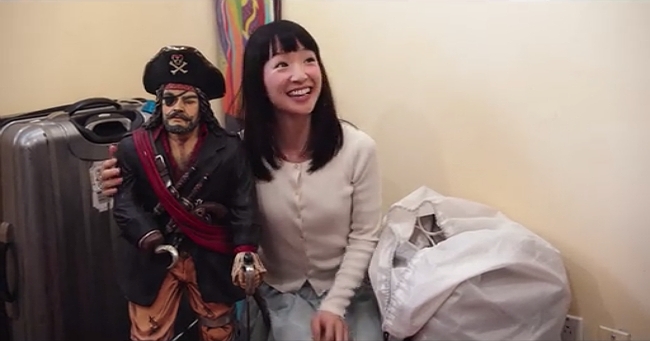
It’s extremely easy to like the people Marie Kondo and her translator are trying to help here. And each episode has mini-segments that show off Kondo’s method for folding various items — hoodies, bras, socks — and how she would store the miscellaneous items that often pile up without a true home. If those vignettes appeal to you, the show is actually teaching you how to tidy when you decide to get off the couch and do some cleaning for yourself.
And that’s the best thing about Tidying Up: it’s a home improvement show that’s not about granite countertops and busting up structurally insignificant walls to create an open floor plan and, in the process, a better life. It’s about taking all the stuff that people already own, paring it down a bit, organizing the rest of it, and perhaps actually making people feel better and less stressed. It’s the perfect home improvement show for people who actually want to live a better life. And, in theory, it costs nothing. Just fold some shirts into threes and admit that you’re never going to read that book and give it away. It’s going to be OK, man.
It’s also very hokey. Kondo “greets” every house she tidies, a meditation of sorts that the show adds inspirational music to. But everyone seems happy once it’s done, and as much as the phrase ‘spark joy’ makes me entirely uncomfortable, it’s an entirely practical method of deciding what matters to you and what’s just, well, stuff. Watching can be a very soothing experience, and also one that’s motivational. There are no artificial high stakes like most American home shows shove into the narrative. No tense teasers leading to commercial breaks — just families embracing Kondo’s method and finding personal and emotional growth in the process. No one is stripping wallpaper or making emergency trips to Home Depot struggling to stay under budget.
There are lessons to be learned from the eight-episode arc, but also pitfalls to the mysticism the show often leads to. The most obvious example is Sanita Mattison, who kept insisting problem areas of the home will be fixed once Kondo does her “magic” to her home. But the host isn’t making the decisions about what to keep or what to get rid of. She almost certainly wants you to huck out your extraneous garbage, but she’s only going to lean you that way. Everyone on the show is putting their clothing into a big pile, touching each item and thanking it verbally if they intend to get rid of it. And some of the piles are truly massive.
“I mean, I get it, Marie,” said Rachel Friend, the young matriarch of a family of four in the show’s first episode. “You look sweet, but on the inside, you mean business.”
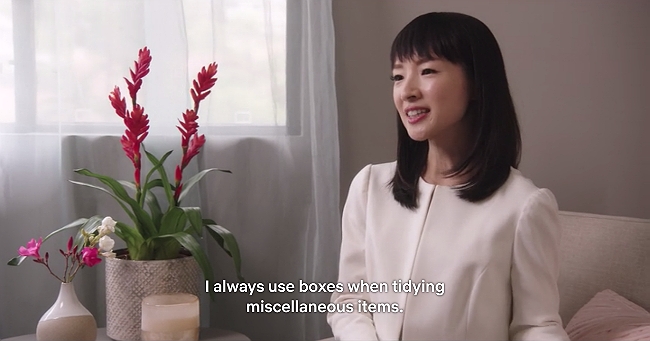
Friend is entirely correct here: Kondo looks charming and quaint and seems to lead a perfectly tidy existence with her two adorable children, often featured throughout the episodes. Her aesthetic presents only of solutions to clutter and projects the inherent calm of empty countertops and the whimsy that comes with tapping books to “wake them up” before you go through them. But it’s also all a vehicle to sell self-help books and $89 storage boxes that are also supposed to “spark joy” in the consumer that needs to store their items upright and folded just so. Taking everything Kondo says here at face value can be, quite frankly, dangerous. And maybe a bit exclusionary, as having too much is often a luxury many simply can’t afford.
“The ultimate goal of tidying is really to learn to cherish everything that you have so that you can achieve happiness for your family so that you can live comfortably,” Kondo says.
In other words, if you are living with too much, you need to break free from things in order to have a better life. After all, you can always just buy more things later, if you really need them. It’s a sentiment said more than once on the show, actually, though it bucks what Kondo’s goal is with the process. There are plenty of people that could use better organization skills. But most people do not have the problem of too much. And even then, eschewing stuff isn’t always the solution to much of anything.
It’s also important to note that all of these people are relatively wealthy and seem to be living comfortably. After all, it’s how they’ve accumulated so much stuff. Almost everyone on the show’s first season has moments where they find clothes and other items they’ve never once worn.
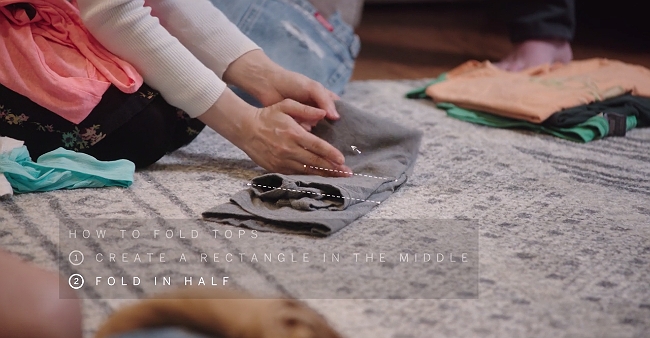
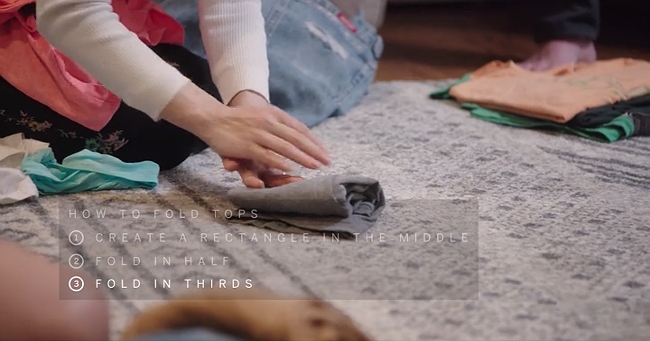
“It’s important to express gratitude to clothes you never wore,” Kondo says. “This is because the shirt taught you that you do not like to wear shirts like this.”
The sentiment reminded me of George Clooney’s backpack speech he gave as a self-help guru in the underrated 2009 film Up In The Air. Clooney’s Ryan Bingham constantly travels and loves living from airport to airport, hotel to hotel. He doesn’t have any “stuff” and in his speech advocates for an existence that doesn’t have any baggage.
“How much does your life weigh,” Bingham asks as he tells people to put on a metaphorical backpack and shove all their possessions in it. The point is that the best life is one of minimal connections, both physical and emotional. And by movie’s end that perspective sits on ground that’s shaky at best. But at least he wasn’t trying to sell anyone anything, he was mostly trying to justify his own existence.
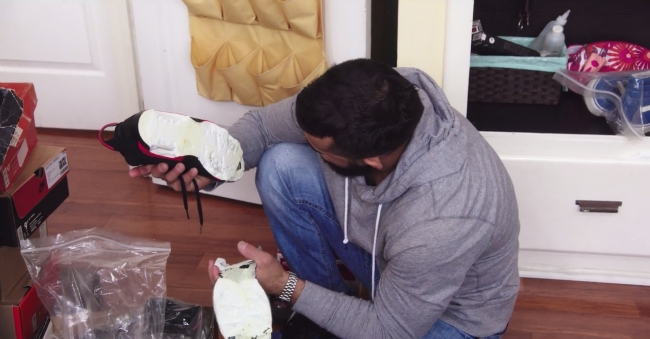
The most striking moment of the show is when Mario, a sneakerhead who’s already condensed his collection down to 160 or so pairs, is forced to actually go through each shoe and get rid of the majority of them. Watching Mario pull out a pair of Jordan 6s he’s never worn and have the soles fall right off was heartbreaking, as was him admitting he slipped $10,000 into credit card debt to build his collection.
“Debt. To tennis shoes,” Mario says. “No, that’s not what I want my little man to think is what life is. I don’t ever want him to glorify anything materialistic.”
Mario struggles to get rid of childhood mementos because his parents sacrificed a lot to give him a happy childhood despite unemployment and economic struggles. Most of the people watching will be a lot closer to Mario and his family than some of the other “clients” that have big homes filled with stuff they feel little about.
“These were real sacrifices my parents were going through,” Mario says, folding up a Notre Dame Fighting Irish Starter jacket his dad bought him for Christmas despite not having a job. “I’ve kept things because I do appreciate what my family has done.”
Kondo’s method says those are things worth keeping, and hopefully those following the method after watching the show aren’t getting rid of things that matter to them. Because Mario is right: no one should slip into credit card debt because of tennis shoes. But they also probably shouldn’t have a credit card full of charges for organizational boxes, either.
‘Tidying Up With Marie Kondo’ is currently streaming on Netflix.






